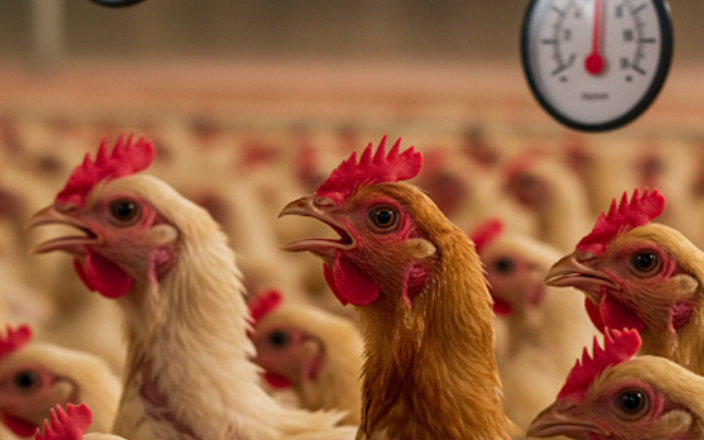Broiler farming is a dynamic business, but one of its biggest challenges is managing birds during hot and humid conditions. While broilers are bred for rapid growth, their ability to regulate body temperature is limited, making them vulnerable to heat stress. This article explores how high temperatures and humidity impact broilers, the consequences for farmers, and practical strategies to prevent and manage heat stress.
The Silent Enemy: Heat and Humidity in Broiler Farming
Just imagine, It’s peak summer, and the broiler shed is buzzing with the restless sounds of panting birds. Farmhands move quickly, trying to reduce heat buildup, but despite their efforts, some birds are struggling. Heat stress is creeping in, threatening productivity, feed conversion, and ultimately, profitability.
Broilers lack sweat glands, making it difficult for them to cool down naturally. Instead, they rely on panting, which increases their energy expenditure and leads to dehydration. The situation worsens when humidity is high, as it reduces the efficiency of evaporative cooling. This creates a dangerous cycle where birds experience distress, reduced feed intake, and lower weight gain.
Impact of Heat Stress on Broilers
Reduced Feed Intake and Growth Performance
When temperatures rise above the comfort zone (18-25°C), broilers eat less to minimize metabolic heat production. This slows down weight gain and results in poor feed conversion efficiency.
Panting and Dehydration
Birds experiencing heat stress pant excessively, leading to loss of carbon dioxide and an imbalance in blood pH (respiratory alkalosis). Prolonged dehydration can lead to organ failure and increased mortality.
Increased Mortality and Lower Flock Uniformity
Under extreme heat, some birds die suddenly due to heatstroke. Survivors may have stunted growth, leading to flock size variation, which affects processing efficiency and market value.
Poor Meat Quality and Higher Fat Deposition
Heat-stressed birds often convert energy into fat rather than muscle. This leads to pale, soft, and exudative (PSE) meat, which reduces consumer acceptance and processor yield.
Weak Immune System and Disease Outbreaks
High temperatures suppress immune function, making birds more susceptible to diseases like Newcastle disease, infectious bronchitis, and mycotoxin-related illnesses.
Preventive Measures: Beating the Heat Before It Strikes
Housing Modifications
- Ventilation: Ensure cross-ventilation with exhaust fans and cool air inlets.
- Roof Insulation: White-painted or reflective roofing materials reduce heat absorption.
- Cooling Systems: Evaporative cooling pads and foggers can reduce shed temperatures by 5-10°C.
- Flooring: Wetting floors in deep-litter systems helps absorb heat and cool the surroundings.
Nutritional Adjustments
- Electrolytes and Vitamins: Supplement water with electrolytes (sodium, potassium) and Vitamin C to combat dehydration and oxidative stress.
- High-Energy, Low-Fiber Diets: Reduce fiber content to lower metabolic heat production while maintaining energy levels.
- Fat Inclusion: Increasing dietary fat (instead of carbohydrates) generates less heat during digestion.
Water Management
- Cool and Clean Water: Water temperature should be below 25°C. Provide shaded water lines and increase access points.
- Frequent Water Changes: Change water regularly to prevent bacterial growth.
Stocking Density and Bird Handling
- Reduce Stocking Density: Overcrowding worsens heat buildup. Maintain recommended space (minimum 1 sq. ft. per bird).
- Gentle Handling: Avoid catching or transporting birds during peak heat hours (12 PM – 4 PM).
Post-Attack Measures: Recovering from Heat Stress
Even with the best management, some birds may suffer from heat stress. Immediate intervention can save lives and minimize production losses.
Emergency Cooling
- Spray birds with cool (not cold) water to reduce body temperature.
- Provide extra fans or misting systems to accelerate heat dissipation.
- Move birds to shadier or well-ventilated areas to improve airflow.
Hydration Therapy
- Administer electrolyte-rich water to restore mineral balance.
- Use glucose and amino acid supplements to boost energy levels and immune function.
Feed Adjustments
- Offer early morning and late evening feedings to encourage intake during cooler hours.
- Include antioxidants like Vitamin E and selenium to repair cell damage from heat stress.
Disease Monitoring and Recovery Support
- Observe birds for post-stress infections and administer necessary medications.
- Implement probiotic supplementation to restore gut health.
Smart Management for a Profitable Broiler Farm
Managing heat and humidity in broiler farming is a battle against nature, but it’s a winnable one. By implementing preventive measures and having a heat-stress response plan, farmers can minimize production losses, improve bird welfare, and ensure consistent growth performance.
As global temperatures continue to rise, adopting climate-smart poultry farming is no longer a choice, it’s a necessity. Are your broilers ready for the next heat wave?
Sources: Available upon request

